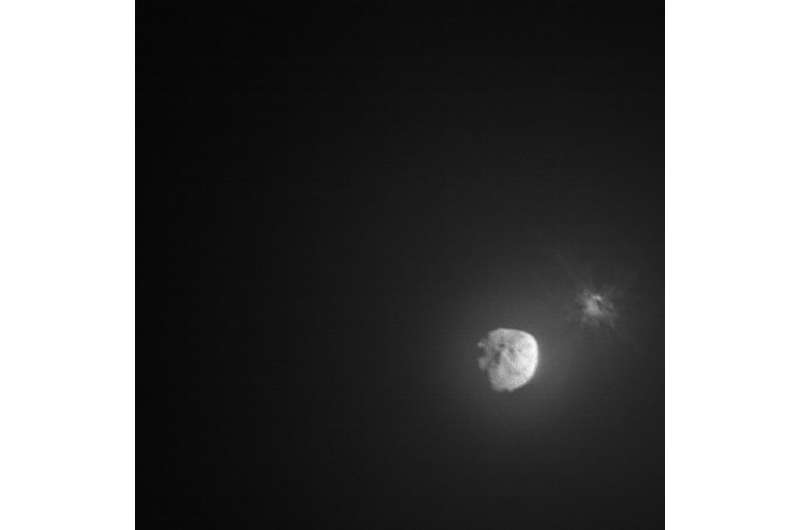
After months of effort, astronomers have succeeded in capturing the momentary shadow cast by the Didymos asteroid, from tens of million kilometers away as it passed in front of far-distant stars—a feat of observation only made possible when both the trajectory of the asteroid and the precise location of the stars are known. Even in that case, to have a chance of success, several observers had to be placed in meticulously predicted locations across the path of the shadow, to glimpse the fleeting fading of the star within just a fraction of a second.
Why even attempt such an ambitious challenge? Because “stellar occultations,” as they are called, are an extraordinary tool to obtain information on shapes and positions of Solar System objects, with an accuracy otherwise impossible for distant observers. And, crucially, the ultra-precise three-dimensional star maps generated by ESA’s Gaia satellite have made this technique much more feasible in recent years.
To target the occultations of Near-Earth asteroids in particular, an ESA-backed project called ACROSS, Asteroid Collaborative Research via Occultation Systematic Survey, was supported by ESA’s Discovery program through a call on the Agency’s Open Space Innovation Platform, seeking out promising space research ideas for support.
Paolo Tanga of Observatoire de la Côte d’Azur, project leader of ACROSS and responsible for Solar System data processing in Gaia, comments that “astrometry based on observing ‘stellar occultations’ was initially exploited for asteroids in the main belt between Mars and Jupiter, then for far-away Trans-Neputnian objects, but ACROSS is extending its systematic exploitation to Near-Earth asteroids as well. This is the challenge: because NEAs move fast and are small, thus producing shorter events and much narrower shadows projected on the ground.”
How to catch NEAs then, using occultations? By improving the accuracy of their trajectories, by diffusing accurate predictions about where and when the events are visible and by mobilizing networks composed both by citizen scientists (motivated amateur astronomers) as well as professionals, on a global scale.
ACROSS has a special focus on Didymos—actually a binary asteroid system, with its 780-m diameter main asteroid orbited by a smaller 160-m diameter moonlet called Dimorphos—the target of NASA’s Double Asteroid Redirect Test, DART. On the night of 26 September the DART spacecraft slammed into the smaller of the two asteroids shifting its orbit.
ESA will then fly the Hera spacecraft to the Didymos system to perform a close-up survey of the post-impact asteroid. Repeating occultations over several years will even permit measurements of the deviation of the system’s trajectory around the Sun induced by DART’s impact—something that cannot be done by DART or Hera alone.
ACROSS co-investigator Prof. Kleomenis Tsiganis of Aristotle University of Thessaloniki, AUTh, adds that “to make such campaigns possible, we needed to perform independent orbit improvement calculations from the currently available data, shrink the uncertainty of the occultation path to a few kilometers, and deploy observers accordingly to catch a momentary blinking out of the star that has to be measured in milliseconds.”
Logistic efforts have been enormous and unsuccessful for several weeks, such as in the case of the 45 observers deployed in Portugal, Spain and Algeria on 25 August, but prevented from observing by adverse meteorological conditions.
In the meantime, efforts on all fronts including a close collaboration with the NASA Jet Propulsion Laboratory’s Steve Chesley of the DART team, improved the predictions further.
And then, success came: The first confirmation came on 15 October from the deployment of six telescopes, five of which were overseen by a single observer, Roger Venable, in northern Oklahoma, U.S., the other by Robert Dunford. One of them—at 9:02 CEST—clearly caught the fading of the star over about 0.13 seconds, just slightly shorter than the maximum possible duration.
Then, on 18 October came the turn of a team led by Jose-Luis Ortiz observing an event very close to his home institute, the Instituto de Astrofisica de Andalucia-CSIC, near Granada in Spain. Miguel Sanchez, equipped with a portable telescope of 28 cm aperture, clearly recorded the occultation with an excellent agreement to predictions.
Later, on the same day, in Japan, some seven telescopes were deployed; those of Hayato Watanabe and Miyoshi Ida through the Japan Occultation Information Network (JOIN) were the lucky ones—this being the first event to be observed by two sites.
With Didymos’ eclipsing of the stars behind it caught by the first time by astronomers, future events will be easier to catch. Observing more of them should ensure a much more accurate tracking of Didymos orbit, possibly allowing the detection of a tiny change in the heliocentric orbit of Didymos due to the DART impact, and even hope to learn more about the scars left by DART’s impact.
Explore further
NASA’s Hubble spots twin tails in new image after DART impact
Shadow hunters capture Didymos asteroid eclipsing stars (2022, October 20)
retrieved 21 October 2022
from https://phys.org/news/2022-10-shadow-hunters-capture-didymos-asteroid.html
part may be reproduced without the written permission. The content is provided for information purposes only.